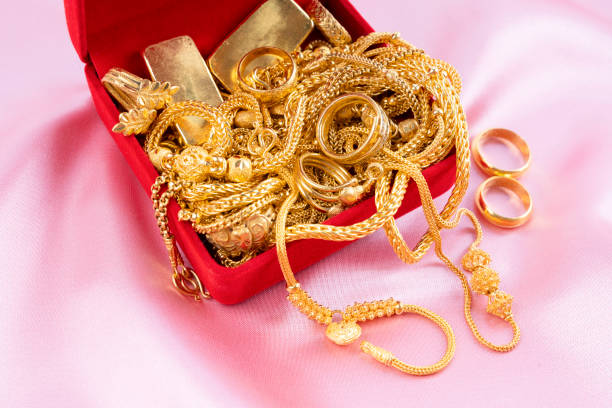Beginner’s Guide to Identifying Real Gold, Diamond, and Jade
In a world flooded with imitation jewelry and misleading sellers, learning how to identify real gold, diamonds, and jade is more essential than ever—especially for beginners. Whether you’re buying for investment, sentimental reasons, or just for the love of beauty, knowing what’s real and what’s not can save you time, money, and disappointment.
Understanding the Basics: What Makes a Gem "Real"?
Before diving into identification methods, it's helpful to understand what qualifies as "real":
- Real gold is a naturally occurring precious metal, typically marked with purity stamps like 24K, 18K, etc.
- Real diamonds are crystallized carbon, rated for their cut, clarity, color, and carat (the 4Cs).
- Real jade refers to either jadeite or nephrite, each with distinct features, and both far more valuable than imitations made from glass or plastic.
Step-by-Step: How to Identify Real Gold
1. Check for Hallmarks
Real gold is usually stamped with a hallmark indicating purity:
- 24K (99.9%), 18K (75%), 14K (58.3%), or 10K (41.7%) Look for small stamps like “18K,” “750,” or “AU.” These are often found on the clasp, inner ring band, or back of pendants.
2. Magnet Test
Gold is not magnetic. If your item is attracted to a magnet, it likely contains other metals.
3. Skin Discoloration Test
Real gold won’t leave green or black marks on your skin. Discoloration is a sign of lower-quality metal or plating.
4. Acid or Scratch Test
Gold testing kits using nitric acid can indicate authenticity. But these tests may damage the item, so they’re best left to professionals unless you know what you’re doing.
How to Spot a Real Diamond
1. Fog Test
Breathe on the diamond—a real diamond disperses heat instantly and won’t stay fogged for more than a second. Fakes will fog up like glass.
2. Read-Through Test
Place the diamond over text. If you can clearly read the letters through it, it’s probably not real. Real diamonds refract light so strongly, you shouldn't see a clear image.
3. Light Reflection
A genuine diamond reflects white and rainbow light, but fakes like cubic zirconia often show just rainbow sparkles, making them look too flashy.
4. Use a Diamond Tester
This handheld tool measures thermal conductivity. Diamonds disperse heat quickly; testers can provide immediate readings. Affordable and beginner-friendly.
Identifying Real Jade
1. Look at the Surface
Real jade often has a smooth, waxy feel and subtle, cloudy patterns. Fakes tend to be overly shiny or perfectly clear.
2. Sound Test
Tap the jade gently against another piece of stone or jade. Real jade gives a deep, resonant sound while imitations make a plastic-like “clack.”
3. Weight and Temperature
Jade is dense and cool to the touch, even in warm environments. Lightweight or warm-feeling stones are often fake.
4. Scratch Test (With Caution)
Real jade is tough. It won’t scratch easily. Be cautious—this test can damage softer materials, so it’s better used on inconspicuous parts.
Common Scams & How to Avoid Them
1. Fake Hallmarks or Laser Engraving
Counterfeiters often stamp fake markings to fool buyers. Always pair visual checks with physical or chemical testing.
2. Overpriced Certificates
Be cautious of sellers offering fake certificates or using impressive-sounding but unrecognized gemological labs.
3. Clever Lighting Tricks
Jewelry stores sometimes use special lighting to make fakes sparkle more. Ask to view the piece under natural light.
4. Misleading Terminology
Words like “gold-plated,” “diamond simulant,” or “jade glass” may sound legitimate but usually refer to imitations.
Do You Need Certification?
1. What Is GIA?
The Gemological Institute of America (GIA) is one of the most trusted certification bodies for diamonds and gemstones. Their reports are detailed, objective, and globally recognized.
2. When Should You Get Certified?
- If you plan to resell or insure your item
- If the piece is high in value
- When buying from a source you’re unsure about
3. Local Appraisals vs. GIA
While local appraisers are more accessible, not all are accredited. If possible, look for appraisers with GIA or AGS credentials. A second opinion can also add peace of mind.
Final Thoughts: Knowledge Is Your Best Protection
Learning to identify real gold, diamonds, and jade doesn't mean you need to be an expert overnight. But understanding these key techniques and warning signs helps you:
- Shop smarter
- Avoid scams
- Value what you already own
And most importantly, it puts the power back in your hands. When in doubt, always pair your judgment with professional help—and trust your instincts.
